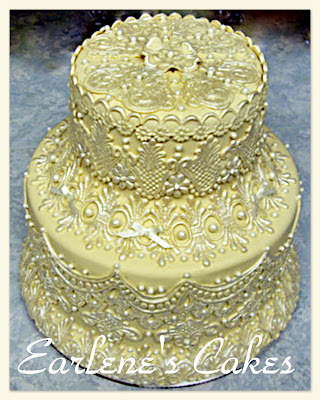
Materials:
Cookie sheets or cake cardboards
Tape
Waxed Paper
2 cups Royal Icing
Blue, Green, Red and Yellow coloring pastes/gels
Parchment or pastry bags
Piping Tips- #2,#3,#12,#86
Art Brush
10” Square Cake Layer
Quarter Sheet Cake Drum
Black Food-coloring Marker
Matching Ribbon
Glue Stick
Instructions:

1. Make several copies of each animal-shaped pattern and the letters from patterns below. Attach them to a firm, smooth surface that can be set aside. Cover the patterns with waxed paper and tape them into place. Remove 1/3 of prepared royal icing and set aside. Divide the remainder into 5 portions and tint with light blue, dark blue, green, red and yellow. Load a small handful of icing into a small piping bag fit with tip #3, then pipe the outline of each figure, being careful not to leave any gaps in the outline. Use a damp brush to help correct mistake and join line together.

2. Add drops of water, one at a time to the remaining colored icing until a ribbon of icing melts into the icing below it in 10 seconds. *Use tip #2 to flood each outline, building it up until the icing has a puffy, raised appearance. Allow the decorations to dry at least 24 hours. Repeat the process with the crib rail panels using the white icing.

3. Cut the cake in half, creating two rectangular 5 x 10” layers. Fill and stack on a cake drum, using a dab of buttercream icing to secure. Cover the cake with buttercream icing. Carefully remove the dried floodwork from the waxed paper with a thin, flexible spatula. ( Or you can pull the paper to the edge of a table or countertop; then pull the paper slowly over the edge, catching the piece as it comes from with your other hand.) Attach the bed rails to the cake, positioning them 1” above the surface cake drum.

4. Pipe green and red stripes across the front of the cake using tip #12, ending the bottom of stripe 1” above surface of cake drum. Alternate the colors randomly, piping 1-3 stripes of the same color before switching.
 5. Pipe a red bead border around the base of the cake using tip #12.
5. Pipe a red bead border around the base of the cake using tip #12.
6. Using tip #86, pipe a green ruffle around the entire cake just above the bead border, splitting the distance between the bead border and the bottom edge fo the rails/stripes. While piping, wiggle the tip in a very tight zigzag motion to achieve the ruffled appearance.

7. Pipe another green ruffle across the top of the stripes at the top edge of the bed’s front side.


8. With tip #86, pipe a second ruffle around the base of the cake in red. Expose just a little of the green ruffle below, keeping the top edge against the base of the bed rails and stripes. Add facial details to the animals using a black food-colouring marker. Arrange animals and letters on the bed and around the base, using buttercream to prop them up. Finish the cake drum by attaching pretty matching ribbon using a glue stick.
* Handy Tip from Mame... Begin piping the figure with two colors first. Pipe and flood the smaller portions, allowing the icing to crust. Then finish with the second color. I flooded the backside of the dry, completed figures to provide a more finished, 3-D appearance. You may choose to finish the pieces with only one layer.
*****************
PATTERNS



 Tutorial by Mame Recckio-Wolfe
Tutorial by Mame Recckio-Wolfe
2009. all rights reserved
Photography by Katie Hilbert
2009. all rights reserved
This material may not be republished or reproduced in any manner without the expressed permission of the author.
*************************
You can find wonderful tutorials just like this one in every issue of American Cake Decorating Magazine. Order your subscription today!!



 Tutorial by Mame Recckio-Wolfe
Tutorial by Mame Recckio-Wolfe2009. all rights reserved
Photography by Katie Hilbert
2009. all rights reserved
This material may not be republished or reproduced in any manner without the expressed permission of the author.
*************************
You can find wonderful tutorials just like this one in every issue of American Cake Decorating Magazine. Order your subscription today!!









































